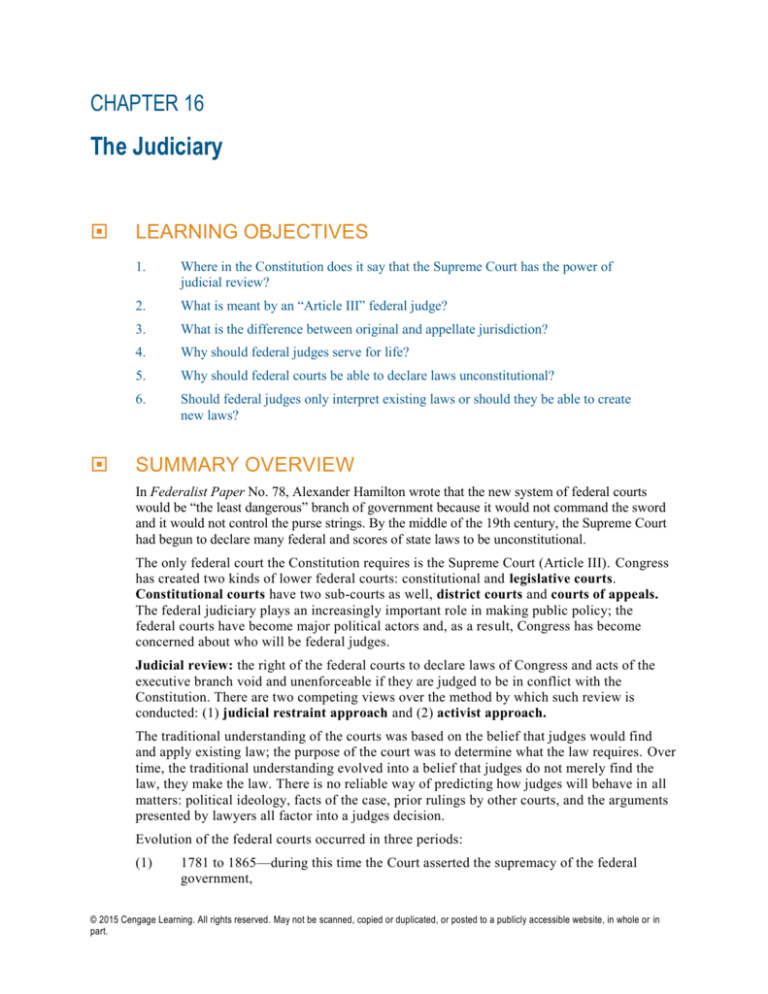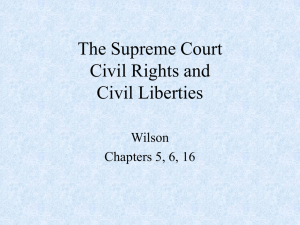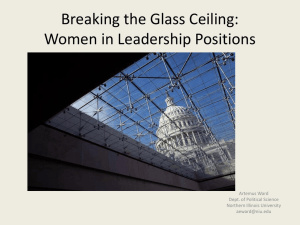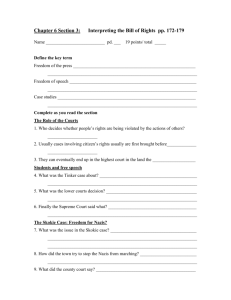
CHAPTER 16
The Judiciary
LEARNING OBJECTIVES
1.
Where in the Constitution does it say that the Supreme Court has the power of
judicial review?
2.
What is meant by an “Article III” federal judge?
3.
What is the difference between original and appellate jurisdiction?
4.
Why should federal judges serve for life?
5.
Why should federal courts be able to declare laws unconstitutional?
6.
Should federal judges only interpret existing laws or should they be able to create
new laws?
SUMMARY OVERVIEW
In Federalist Paper No. 78, Alexander Hamilton wrote that the new system of federal courts
would be “the least dangerous” branch of government because it would not command the sword
and it would not control the purse strings. By the middle of the 19th century, the Supreme Court
had begun to declare many federal and scores of state laws to be unconstitutional.
The only federal court the Constitution requires is the Supreme Court (Article III). Congress
has created two kinds of lower federal courts: constitutional and legislative courts.
Constitutional courts have two sub-courts as well, district courts and courts of appeals.
The federal judiciary plays an increasingly important role in making public policy; the
federal courts have become major political actors and, as a result, Congress has become
concerned about who will be federal judges.
Judicial review: the right of the federal courts to declare laws of Congress and acts of the
executive branch void and unenforceable if they are judged to be in conflict with the
Constitution. There are two competing views over the method by which such review is
conducted: (1) judicial restraint approach and (2) activist approach.
The traditional understanding of the courts was based on the belief that judges would find
and apply existing law; the purpose of the court was to determine what the law requires. Over
time, the traditional understanding evolved into a belief that judges do not merely find the
law, they make the law. There is no reliable way of predicting how judges will behave in all
matters: political ideology, facts of the case, prior rulings by other courts, and the arguments
presented by lawyers all factor into a judges decision.
Evolution of the federal courts occurred in three periods:
(1)
1781 to 1865—during this time the Court asserted the supremacy of the federal
government,
© 2015 Cengage Learning. All rights reserved. May not be scanned, copied or duplicated, or posted to a publicly accessible website, in whole or in
part.
112
Chapter 16: The Judiciary
(2)
1865 to 1937—during this time it placed important restrictions on the powers of that
government, and
(3)
1938 to present—during this time it enlarged the scope of personal freedom and
narrowed that of economic freedom.
From 1789 until the Civil War, the dominant interest of the Supreme Court was the nation state relationship (decided by Marbury v. Madison (1803), and McCulloch v. Maryland,
(1819). From the end of the Civil War to the early years of the New Deal, the dominant
interest of the Supreme Court was deciding when the economy would be regulated by the
states and when by the nation. From 1937 to 1953 the dominant interest of the Supreme Court
was political liberties and, ultimately, civil rights. From 1953 to about 1992 the Court began
to redefine the relationship of citizens to the government and especially to protect the rights
and liberties of citizens from governmental trespass. Since 1992 the Court has begun to
restore the view that states have the right to resist some forms of federal action.
The great majority of the cases heard in the federal courts have little or nothing to do with
changes in public policy; in most instances, the courts are simply applying a relatively settled
body of law to a specific controversy. The courts make policy whenever they reinterpret the
law or the Constitution in significant ways, extend the reach of existing laws to cover matters
not previously thought to be covered by them, or design remedies for problems that involve
the judges’ acting in administrative or legislative ways.
The Measures of Power of the Federal Courts.
(1)
Since 1789, more than 160 federal laws have been declared unconstitutional.
(2)
Another measure of judicial power is the frequency with which the Supreme Court
changes its mind.
(3)
A third measure is the degree to which courts are willing to handle matters once left
to the legislature.
(4)
Today, judges design the kinds of remedies that the courts will impose.
Congress has a number of ways of checking the judiciary: it can gradually alter the
composition of the judiciary by the kinds of appointments the Senate is willing to confirm, or
impeach judges. Congress can alter the number of judges. Congress and the states can also
undo a Supreme Court decision interpreting the Constitution by amending that document.
Congress can decide what the entire jurisdiction of the lower courts and appellate jurisdiction
of the Supreme Court shall be.
CHAPTER OUTLINE
I.
Judicial Review
II.
The Development of the Federal Courts
A.
National Supremacy and Slavery
B.
Government and the Economy
C.
Government and Political Liberty
© 2015 Cengage Learning. All rights reserved. May not be scanned, copied or duplicated, or posted to a publicly accessible website, in whole or in
part.
Chapter 16: The Judiciary
D.
III.
The Revival of State Sovereignty
The Structure of the Federal Courts
A.
Selecting Judges
1.
Senatorial Courtesy
2.
The “Litmus Test”
IV.
The Jurisdiction of the Federal Courts
V.
Getting to Court
A.
Fee Shifting
B.
Standing
C.
Class-Action Suits
VI.
The Supreme Court in Action
VII.
The Power of the Federal Courts
VIII.
113
A.
The Power to Make Policy
B.
Views of Judicial Activism
C.
Legislation and the Courts
Checks on Judicial Power
A.
Congress and the Courts
B.
Public Opinion and the Courts
TEACHING TOOLS
LEARNING OBJECTIVE 1: WHERE IN THE CONSTITUTION DOES IT SAY THAT
THE SUPREME COURT HAS THE POWER OF JUDICIAL REVIEW?
Critical Thinking Question
Explain judicial review; where does the Supreme Court receive this power from?
In-Class Activity
Have the class identify and explain the powers of the Supreme Court.
Lecture Launcher
Discuss the purpose of the federal courts with the class.
LEARNING OBJECTIVE 2: WHAT IS MEANT BY AN “ARTICLE III”
FEDERAL JUDGE?
Critical Thinking Question
Explain the process by which a judge is appointed, or not, to a federal judgeship.
© 2015 Cengage Learning. All rights reserved. May not be scanned, copied or duplicated, or posted to a publicly accessible website, in whole or in
part.
114
Chapter 16: The Judiciary
In-Class Activity
Divide the class into four groups; each group will choose a Supreme Court Justice from different
eras and will report on how each judge received their post. Have the class discuss the difference
and difficulties each judge had in obtaining their seat.
Lecture Launcher
Discuss with the class the changing role of the Supreme Court through the decades.
Learning Objective 3: WhaT IS THE DIFFERENCE BETWEEN ORIGINAL AND
APPELLATE JURISDICTION?
Critical Thinking Question
Explain the difference between a court case tried under original jurisdiction and a court case tried
under appellate jurisdiction.
In-Class Activity
Have the class identify the different methods a case can be tried at the federal level.
Lecture Launcher
Pose the following to the class: True or false; any case can be brought before a federal court?
Why or why not?
Learning Objective 4: WHY SHOULD FEDERAL JUDGES SERVE FOR LIFE?
Critical Thinking Question
Argue whether Supreme Court justices should serve fixed terms or life appointments. Why?
In-Class Activity
Have the class identify pros and cons for lifetime judgeships.
Lecture Launcher
Ask the class to consider the worth of lifetime appointments given the current nomination process
for judges.
Learning Objective 5: WHY SHOULD FEDERAL COURTS BE ABLE TO DECLARE
LAWS UNCONSTITUTIONAL?
Critical Thinking Question
Consider the Founders intention for the federal courts. How does the power to declare laws
unconstitutional elevate the power of the federal courts?
© 2015 Cengage Learning. All rights reserved. May not be scanned, copied or duplicated, or posted to a publicly accessible website, in whole or in
part.
Chapter 16: The Judiciary
115
In-Class Activity
Ask the class to identify major court cases that have resulted in the courts declaring laws
unconstitutional.
Lecture Launcher
Ask the class if the Supreme Court should, in fact, have the power to declare laws
unconstitutional.
Learning Objective 6: SHOULD FEDERAL JUDGES ONLY INTERPRET EXISTING
LAWS OR SHOULD THEY BE ABLE TO CREATE NEW LAWS?
Critical Thinking Question
Explain the checks and balances against the federal courts.
In-Class Activity
Discuss the merits, or lack thereof, to limit the role of federal judges to simplify interpreting laws
as opposed to creating new laws. Include the Constitutionality of each viewpoint in the
discussion.
Lecture Launcher
The instructor will begin the lecture with the following statement: federal court decisions create
new laws.
KEY TERMS
activist approach
The view that judges should discern the general principles
underlying laws or the Constitution and apply them to modern
circumstances.
amicus curiae
A brief submitted by a “friend of the court.”
brief
A written statement by an attorney that summarizes a case and
the laws and rulings that support it.
class-action suit
A case brought by someone to help both himself or herself and
all others who are similarly situated.
concurring opinion
A signed opinion in which one or more members agree with the
majority view but for different reasons.
constitutional court
A federal court authorized by Article III of the Constitution that
keeps judges in office during good behavior and prevents their
salaries from being reduced. They are the Supreme Court
(created by the Constitution) and appellate and district courts
created by Congress.
courts of appeals
Federal courts that hear appeals from district courts; no trials.
© 2015 Cengage Learning. All rights reserved. May not be scanned, copied or duplicated, or posted to a publicly accessible website, in whole or in
part.
116
Chapter 16: The Judiciary
dissenting opinion
A signed opinion in which one or more justices disagree with the
majority view.
district courts
The lowest federal courts; federal trials can be held only here.
diversity cases
Cases involving citizens of different states who can bring suit in
federal courts.
federal-question cases
Cases concerning the Constitution, federal laws, or treaties.
fee shifting
A rule that allows a plaintiff to recover costs from the
defendant if the plaintiff wins.
in forma pauperis
A method whereby a poor person can have his or her case heard
in federal court without charge.
judicial restraint approach
The view that judges should decide cases strictly on the basis of
the language of the laws and the Constitution.
judicial review
The power of courts to declare laws unconstitutional.
Legislative courts
Courts created by Congress for specialized purposes whose
judges do not enjoy the protections of Article III of the
Constitution.
litmus test
An examination of the political ideology of a nominated judge.
opinion of the Court
A signed opinion of a majority of the Supreme Court.
per curiam opinion
A brief, unsigned court opinion.
plaintiff
The party that initiates a lawsuit.
political question
An issue the Supreme Court will allow the executive and
legislative branches to decide.
remedy
A judicial order enforcing a right or redressing a wrong.
sovereign immunity
The rule that a citizen cannot sue the government without the
government’s consent.
standing
A legal rule stating who is authorized to start a lawsuit.
stare decisis
“Let the decision stand,” or allowing prior rulings to control the
current case.
writ of certiorari
An order by a higher court directing a lower court to send up a
case for review.
WEB LINKS
Federal Judicial Center: www.fjc.gov
Federal courts: www.uscourts.gov
Supreme Court decisions: www.law.cornell.edu
Finding laws and reports: www.findlaw.com
© 2015 Cengage Learning. All rights reserved. May not be scanned, copied or duplicated, or posted to a publicly accessible website, in whole or in
part.
Chapter 16: The Judiciary
117
INSTRUCTOR RESOURCES
Abraham, Henry J. The Judicial Process, 7th ed. New York: Oxford University Press, 1998. An
excellent, comprehensive survey of how the federal courts are organized and function.
Abraham, Henry J., and Barbara A. Perry. Freedom and the Court, 8th ed. Lawrence, KS:
University of Kansas Press, 2003. Careful summary of civil liberties and civil
rights cases.
Cardozo, Benjamin N. The Nature of the Judicial Process. New Haven, CT: Yale University
Press, 1921. Important statement of how judges make decisions, by a former Supreme
Court justice.
Ely, John Hart. Democracy and Distrust. Cambridge: Harvard University Press, 1980. Effort to
create a theory of judicial review that is neither strict-constructionist nor activist.
Greenburg, Jan Crawford. Supreme Conflict. New York: Penguin, 2007. A fascinating journalistic
account of how the Supreme Court operates.
Hall, Kermit L., and James W. Ely, Jr., eds. The Oxford Guide to the United States Supreme
Court Decisions, 2nd ed. New York: Oxford University Press, 2009. Summarizes the 440
most important decisions of the Supreme Court and includes a comprehensive
bibliography of books about the Court.
Lasser, William. The Limits of Judicial Power. Chapel Hill: University of North Carolina Press,
1988. Shows how the Court through history has withstood the political storms created by
its more controversial decisions.
McCloskey, Robert G. The American Supreme Court, 4th ed. Edited by Sanford Levinson.
Chicago: University of Chicago Press, 2005. Superb brief history of the Supreme Court,
updated by one of McCloskey’s former students who now teaches law at the University
of Texas.
Rabkin, Jeremy. Judicial Compulsions. New York: Basic Books, 1989. Explains (and argues
against) the extensive Court intervention in the work of administrative agencies.
Wolfe, Christopher. The Rise of Modern Judicial Review. New York: Basic Books, 1986. An
excellent history of judicial review from 1787 to the present.
© 2015 Cengage Learning. All rights reserved. May not be scanned, copied or duplicated, or posted to a publicly accessible website, in whole or in
part.










